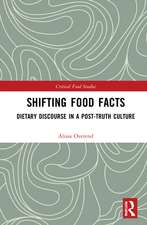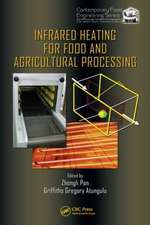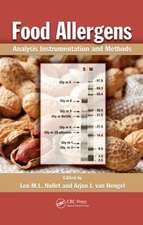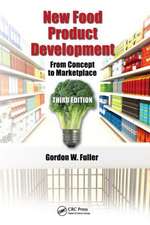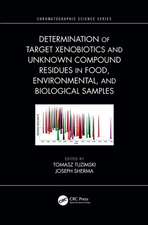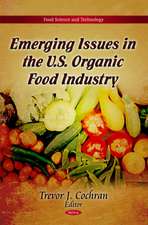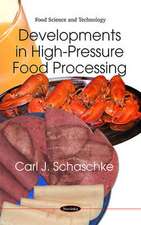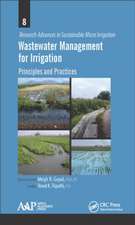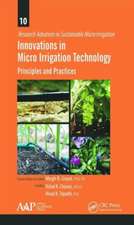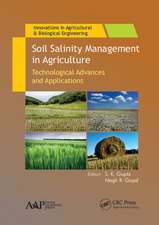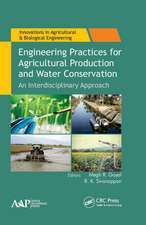Food Technology: Applied Research and Production Techniques: Innovations in Agricultural & Biological Engineering
Editat de Murlidhar Meghwal, Megh R. Goyal, Mital J. Kaneriaen Limba Engleză Hardback – 10 aug 2017
Features:
- provides information on relevant technology
- makes suggestions for equipment and devices
- looks at standardization in food technology
- explores new and innovative packaging technology
- studies antimicrobial activities in food
- considers active constituents of foods and provides information about isolation, validation and characterization of major bioactive constituents
- discusses the effect of laws and regulatory guidelines on infrastructure to transform technology into highly value-added products
| Toate formatele și edițiile | Preț | Express |
|---|---|---|
| Paperback (1) | 497.00 lei 6-8 săpt. | |
| Apple Academic Press Inc. – 31 mar 2021 | 497.00 lei 6-8 săpt. | |
| Hardback (1) | 746.17 lei 6-8 săpt. | |
| Apple Academic Press Inc. – 10 aug 2017 | 746.17 lei 6-8 săpt. |
Din seria Innovations in Agricultural & Biological Engineering
-
 Preț: 687.29 lei
Preț: 687.29 lei - 22%
 Preț: 496.40 lei
Preț: 496.40 lei - 22%
 Preț: 497.73 lei
Preț: 497.73 lei - 15%
 Preț: 579.62 lei
Preț: 579.62 lei - 15%
 Preț: 579.62 lei
Preț: 579.62 lei - 15%
 Preț: 592.71 lei
Preț: 592.71 lei - 15%
 Preț: 603.70 lei
Preț: 603.70 lei - 15%
 Preț: 590.09 lei
Preț: 590.09 lei - 22%
 Preț: 494.04 lei
Preț: 494.04 lei - 15%
 Preț: 579.62 lei
Preț: 579.62 lei - 15%
 Preț: 590.77 lei
Preț: 590.77 lei - 23%
 Preț: 491.24 lei
Preț: 491.24 lei - 22%
 Preț: 498.67 lei
Preț: 498.67 lei - 9%
 Preț: 580.03 lei
Preț: 580.03 lei - 23%
 Preț: 491.24 lei
Preț: 491.24 lei - 18%
 Preț: 952.32 lei
Preț: 952.32 lei - 15%
 Preț: 586.52 lei
Preț: 586.52 lei - 25%
 Preț: 604.53 lei
Preț: 604.53 lei - 22%
 Preț: 500.50 lei
Preț: 500.50 lei - 25%
 Preț: 835.74 lei
Preț: 835.74 lei - 18%
 Preț: 1015.55 lei
Preț: 1015.55 lei - 25%
 Preț: 603.40 lei
Preț: 603.40 lei - 15%
 Preț: 579.62 lei
Preț: 579.62 lei - 23%
 Preț: 491.24 lei
Preț: 491.24 lei - 22%
 Preț: 497.00 lei
Preț: 497.00 lei - 22%
 Preț: 496.02 lei
Preț: 496.02 lei - 9%
 Preț: 911.03 lei
Preț: 911.03 lei - 15%
 Preț: 584.71 lei
Preț: 584.71 lei - 22%
 Preț: 496.58 lei
Preț: 496.58 lei - 22%
 Preț: 497.16 lei
Preț: 497.16 lei - 18%
 Preț: 951.69 lei
Preț: 951.69 lei - 15%
 Preț: 579.62 lei
Preț: 579.62 lei - 15%
 Preț: 586.02 lei
Preț: 586.02 lei - 25%
 Preț: 796.09 lei
Preț: 796.09 lei - 18%
 Preț: 1012.07 lei
Preț: 1012.07 lei - 15%
 Preț: 589.98 lei
Preț: 589.98 lei
Preț: 746.17 lei
Preț vechi: 995.47 lei
-25% Nou
Puncte Express: 1119
Preț estimativ în valută:
142.82€ • 148.54$ • 119.68£
142.82€ • 148.54$ • 119.68£
Carte tipărită la comandă
Livrare economică 14-28 martie
Preluare comenzi: 021 569.72.76
Specificații
ISBN-13: 9781771885096
ISBN-10: 1771885092
Pagini: 412
Ilustrații: 84
Dimensiuni: 152 x 229 mm
Greutate: 1 kg
Ediția:1
Editura: Apple Academic Press Inc.
Colecția Apple Academic Press
Seria Innovations in Agricultural & Biological Engineering
ISBN-10: 1771885092
Pagini: 412
Ilustrații: 84
Dimensiuni: 152 x 229 mm
Greutate: 1 kg
Ediția:1
Editura: Apple Academic Press Inc.
Colecția Apple Academic Press
Seria Innovations in Agricultural & Biological Engineering
Public țintă
Academic and PostgraduateCuprins
Good Manufacturing Practices for Food Processing Industries: Principles and Practical Applications. Research Planning and Funding Agencies: Focus on Food Technology. Food Industry: Use of Plastics in Twenty-First Century. Thermal Processing In Food Technology: Latest Trends. Non-Destructive Technique of Soft X-Ray for Evaluation of Internal Quality of Agricultural Produce. In Vitro Antioxidant Efficacy: Selected Medicinal Plants of Gujarat. Antioxidant Activities of Some Marine Algae: Case Study from India. Omega-3 Pufafrom Fish Oil: Silver Based Solvent Extraction. Anti-Oxidant and Anti-Baterial Characteristics of Extracts: Terminalia chebula and Terminalia bellerica. In Vitro Antimicrobial Activity: Salvadora Species. Antimicrobial Properties of Leaf Extract: Polyalthia Longifolia var. Pendula Under In-Vitro Conditions. Isolation, Validation and Characterization of Major Bioactive Constituents from Mango Ripe Seed. Isolation and Characterization of Lycopene from Tomato and Its Biological Activity. Food Processing using Microbial Control System: Shea Butter.
Recenzii
FOOD TECHNOLOGY – APPLIED
RESEARCH AND PRODUCTION
TECHNIQUES
Editors : Muralidhar Meghwal,
Megh R. Goyal and Mital J. Kaneria
Publishers : CRC Press
Taylor & Francis Group
Year : 2018
No. of Pages : 349
Price : CHF: 130, USD: 127.909,
INR: 8872.03
The Book entitled “FOOD
TECHNOLOGY – APPLIED RESEARCH
AND PRODUCTION TECHNIQUES” consists
of five parts with 14 chapters. Part I deals
with the principles and practices of good
manufacturing processes in food industries.
It also deals with the funding agency that is
helpful to researchers and scientists. The
chapter about the various funding agencies
also gives valuable information on the steps
that should be followed for research funding.
Part II of the book deals with the latest
food technologies followed in the 21st century.
Chapter 3 gives a brief account on the use of
biopolymers instead of plastics that are nondegradable.
This chapter also gives an
overview on food packaging in the early 19th
century and 21st century. Chapter 4 gives an
idea on thermal processing that involves both
temperature and time required to eliminate
microbes from food products. It is an important
aspect that has to be followed in the
packaging industry. Low moisture content
provides shelf-life to the food product. The
thermo gram given in this chapter provides
valuable information that can be used as a tool
for food product designing. Chapter 5 deals
with the non-destructive methods to analyse
the internal quality of the food product.
Part III of the book is about the role of
antioxidants in food. In this part, there are
4 chapters that deal with the ill-effects of
free-radicals that cause damage to the
surrounding molecules. Plants and marine
algae that possess anti-oxidant properties
have been dealt in this part. In chapter 8,
efficient extraction procedure for omega-3-
PUFA from fish-oil has been discussed. In
chapter 9, the use of Terminalia chebula and
Terminalia bellerica as an anti-oxidant and
anti-bacterial agent has been dealt in detail.
Part IV of the book contains 2 chapters
that deal with the antimicrobial efficacy of
different solvent extracts of Salvadora and
Polyalthialongifolia. But, the chemical
constituents of the experimental plants
should be identified in order to gain full
knowledge on their antimicrobial effect.
Part V of the book consists of
3 chapters. In this, chapter 12 deals with the
isolation, validation and characterization of
major bioactive constituents from mango
ripe seed. The chemical structure of the
components is to be analysed in order to
calculate the biological potential. Chapter 13
involves isolation and characterization of
lycopene from tomato. The antioxidant and
antimicrobial effect of lycopene have also
been assessed.
Finally, the last chapter deals with food
processing using microbial control system.
On the whole, the full book gives the readers
the current scenario of research on food
technology, which will be useful to both
Botanists and Nutritionists doing research in
plants and plant products.
Gayathri, V.
RESEARCH AND PRODUCTION
TECHNIQUES
Editors : Muralidhar Meghwal,
Megh R. Goyal and Mital J. Kaneria
Publishers : CRC Press
Taylor & Francis Group
Year : 2018
No. of Pages : 349
Price : CHF: 130, USD: 127.909,
INR: 8872.03
The Book entitled “FOOD
TECHNOLOGY – APPLIED RESEARCH
AND PRODUCTION TECHNIQUES” consists
of five parts with 14 chapters. Part I deals
with the principles and practices of good
manufacturing processes in food industries.
It also deals with the funding agency that is
helpful to researchers and scientists. The
chapter about the various funding agencies
also gives valuable information on the steps
that should be followed for research funding.
Part II of the book deals with the latest
food technologies followed in the 21st century.
Chapter 3 gives a brief account on the use of
biopolymers instead of plastics that are nondegradable.
This chapter also gives an
overview on food packaging in the early 19th
century and 21st century. Chapter 4 gives an
idea on thermal processing that involves both
temperature and time required to eliminate
microbes from food products. It is an important
aspect that has to be followed in the
packaging industry. Low moisture content
provides shelf-life to the food product. The
thermo gram given in this chapter provides
valuable information that can be used as a tool
for food product designing. Chapter 5 deals
with the non-destructive methods to analyse
the internal quality of the food product.
Part III of the book is about the role of
antioxidants in food. In this part, there are
4 chapters that deal with the ill-effects of
free-radicals that cause damage to the
surrounding molecules. Plants and marine
algae that possess anti-oxidant properties
have been dealt in this part. In chapter 8,
efficient extraction procedure for omega-3-
PUFA from fish-oil has been discussed. In
chapter 9, the use of Terminalia chebula and
Terminalia bellerica as an anti-oxidant and
anti-bacterial agent has been dealt in detail.
Part IV of the book contains 2 chapters
that deal with the antimicrobial efficacy of
different solvent extracts of Salvadora and
Polyalthialongifolia. But, the chemical
constituents of the experimental plants
should be identified in order to gain full
knowledge on their antimicrobial effect.
Part V of the book consists of
3 chapters. In this, chapter 12 deals with the
isolation, validation and characterization of
major bioactive constituents from mango
ripe seed. The chemical structure of the
components is to be analysed in order to
calculate the biological potential. Chapter 13
involves isolation and characterization of
lycopene from tomato. The antioxidant and
antimicrobial effect of lycopene have also
been assessed.
Finally, the last chapter deals with food
processing using microbial control system.
On the whole, the full book gives the readers
the current scenario of research on food
technology, which will be useful to both
Botanists and Nutritionists doing research in
plants and plant products.
Gayathri, V.
Notă biografică
Murlidhar Meghwal, Megh R. Goyal, Mital J. Kaneria
Descriere
This new looks at recent developments and innovations in food technology and sustainable technologies. Advanced topics in the volume include food processing, preservation, nutritional analysis, quality control and maintenance as well as good manufacturing practices in the food industries. The chapters are highly focused reports to help direct the development of current food- and agriculture-based knowledge into promising technologies.





